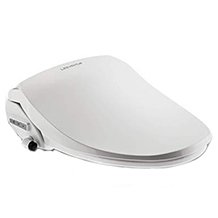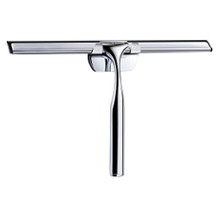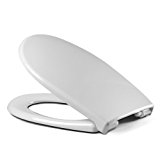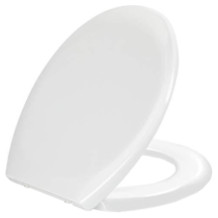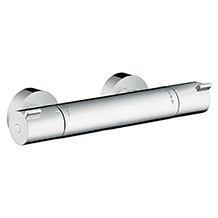Shower head purchasing advice: how to choose the right product
- What you need to know
- Shower heads can mainly be divided into shower handsets and fixed shower heads.
- Most shower heads provide different spray types to offer different showering experiences, such as a pressure massage or a rain spray.
- A water-saving function ensures that you use about 50% less water. However, with some models, the shower experience suffers.
- The installation of shower heads is standardized. All shower heads should therefore fit any hoses and mountings.
Indispensable companions for hygiene
At first glance, showering seems like a banal everyday topic that is rarely given attention. According to YouGov plc, about 66% of US-Americans take a shower every day. Showering also involves hundreds of dollars in electricity and water costs. For many, however, showering is not just about getting clean, but a daily pleasure that offers a few quiet meditative minutes. For others, the shower is their private stage, and the shower head is the microphone.
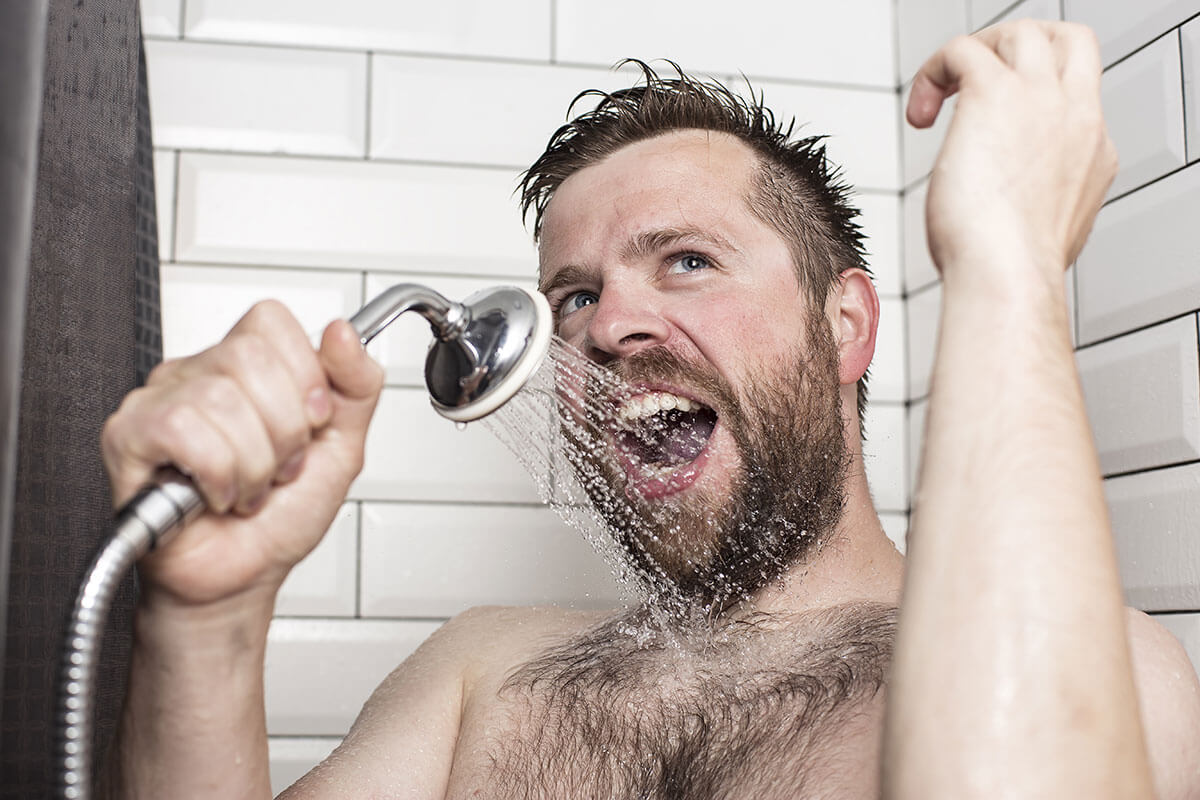
The perhaps most important component of your shower is the shower head, as it has the greatest influence on the overall experience. Different spray types and flow rates determine both water consumption and showering comfort. So whether showering is a simple part of your routine or a daily highlight depends very much on the shower head.
Shower heads would have been a marketing flop in the Middle Ages
Our medieval ancestors did not wash often — some only once in their lives: at their baptism. Meaning that apart from the original sin, nothing else needed to be washed off in their eyes. It was not until around the 18th century that Europeans began to wash more regularly. In East Asia, the relevance of hygiene was recognized much earlier.
The two types of shower heads
Shower heads are usually divided into two types: fixed shower heads and shower handsets. The former are fixed appliances, while the latter can be held in your hand to spray water on hard-to-reach areas of the body. If you have a hard time deciding, you can opt for a shower set. Shower sets include both types, but are more expensive.
Shower handsets
Shower handsets are either operated by hand or mounted on a height-adjustable holder in case you want to keep your hands free. The shower heads are attached to a hose, which sometimes wears out faster than the shower head and needs to be replaced over time. However, mounting both the shower head as well as the hose is usually very straightforward. The hose usually needs to be acquired separately, but is sometimes included in the scope of delivery.
Shower handsets are usually round. Simple, inexpensive models have only one type of spray. However, for as little as $10 to $20, you can find models with different spray types. The diameter of common handsets is between 2.5 and 6 inches (7 and 15cm). Handsets are also the cheapest shower head types. Their biggest advantage is that they can be used selectively. For example, if you have a fresh tattoo, a bandage, or an open wound that should not get wet, you can specifically avoid such areas with a handset.
Advantages
- Flexible
- Often different jet types
- Mostly small and light
- Simple mounting
- Height-adjustable holder
- Inexpensive
Disadvantages
- hose not so durable
Fixed shower heads
Fixed shower heads usually have no hose, as they are permanently installed and cannot be removed. This means that they are not very flexible compared to handsets. On the other hand, both hands remain free for extensive lathering and rubbing. Because they are permanently installed, they can be difficult to mount. Sometimes the help of craftsmen is required, especially if work has to be done under the plastering. During installation, make sure that the shower head is mounted at the correct height; this can rarely be adjusted afterwards. To avoid flooding your bathroom, you should also make sure that the entire jet lands in the tub or shower. This is easy to test, as fixed shower heads usually only have one type of spray.
Rain showers are a special type of fixed shower head. They are usually larger than standard shower heads and have a specific type of spray that covers a large area and provides a gentle rain feeling. With a diameter of 12 to 24 inches (30 to 60cm), rain showers are not exactly space-saving. They also use more water than simple fixed shower heads or even shower handsets. Last but not least, they are a lot more expensive.
Advantages
- No hose
- Free hands
- Pleasant rain feeling in the case of rain showers
Disadvantages
- Inflexible
- Expensive
- Elaborate installation
- High water consumption
What a shower head is made of
Although shower head models often look quite different from one another, their main components are usually the same. For example, all shower handsets have a handle to grab. The shower hose is also attached to them. In the case of fixed shower heads, a metal pipe is usually the connection between the shower head and the faucet. The handle or the pipe is connected to the head. Depending on the type of shower head and model, it can be bar-shaped, round, or square. The head sizes can vary greatly. The head is equipped with small jets from which the water flows. In shower heads with several jet types, these are only partially used, depending on the setting. The surface on which the jets are attached is called a shower plate. Some shower plates come with a rotating device that is used to select the desired spray type.
The most important purchase criteria
When buying a shower head, there are other features to consider besides the type. For example, the presence of a water-saving function and different jet types is important, as these features significantly influence water consumption and showering comfort. Of course, the relevance of such features strongly depends on your personal needs and preferences.
Jet types
Among the most important distinguishing features of shower heads are the different jet types available to users. The number and type varies depending on the model. Very simple models only have one standard spray type. Most shower heads, however, offer between three and seven spray types.
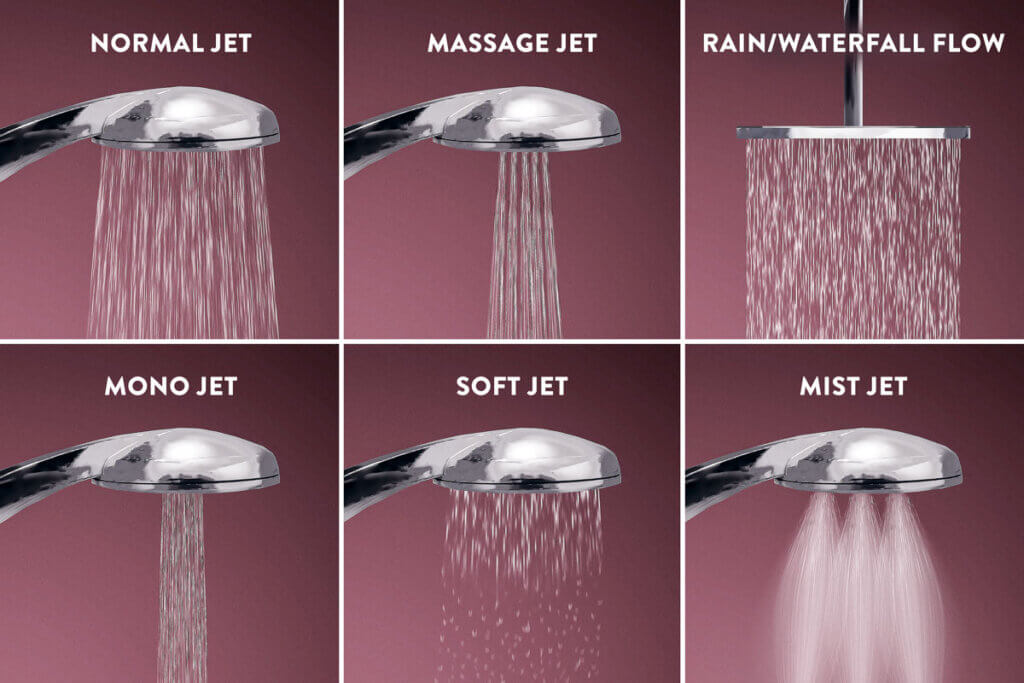
The normal jet is wide and uniform to ensure a comfortable shower experience. This type of jet is good for washing the whole body.
The massage jet lets the water flow out in powerful, thick jets, which creates a pleasant massage sensation. A handset can be held on a specific body part that needs to be massaged.
Rain showers are very popular because of their rain spray. With this type of spray, small drops of water fall gently. This provides a soothing, comforting feeling.
A mono jet is a single concentrated jet that feels particularly hard. It is suitable for spot massage.
Soft jets are small jets that are refined with air. This type of jet is particularly gentle and pleasant.
The mist jet is characterized by several bundled, circular water jets. It has a very invigorating effect and is ideal for waking up — especially on days when you find doing so difficult.
Flow rate
A normal shower head usually uses around 4 gallons (15L) per minute. This results in an average water consumption of about 20 gallons (80L) per shower. Such an amount is not only a burden on the environment, but also on your bank account. That’s why a shower head with a water-saving function or eco-function is a good investment.
With a water-saving function, you use up to 50% less shower water. Various techniques are used to achieve this. The simplest one is to limit the flow rate. However, many users then find the water jets too weak.
Another technique divides the flowing water through many tiny nozzles. In this way, the water is perceived to be more voluminous. However, the thin jets can feel uncomfortable on the skin. Last but not least, some shower heads mix the outflowing water with air, which also makes the flow volume appear larger.
Size and weight
The most important size specification of a shower head is its diameter. As the size increases, the shower heads become heavier. Therefore, when choosing the shower head size, pay attention to the size of the shower or bathtub. If the spray is too wide for your facility, flooding may occur.
Most showers are equipped with handsets. Their diameter is between 2.5 and 6 inches (7 and 15cm). Handsets weigh between 200 and 400g. Fixed shower heads are larger than handsets because they are not held in the hand but spray the user with water over a large area from above. Hence, if your shower head is permanently mounted or is to hang mostly on the holder, its diameter can easily be 6 to 8 inches (15 to 20cm). Rain showers even reach 12 to 24 inches (30 to 60cm). With permanently installed models, weight is hardly an issue.
Number of nozzles
The number of nozzles depends largely on the diameter of the shower head. Simply put, the larger the shower head, the more nozzles. However, the number of jets also depends on another feature, namely the jet types of the shower head. Shower heads with massage jets usually have more nozzles than simple shower heads to ensure the pleasant massage feeling. An increasing number of nozzles usually correlates with a more pleasant showering sensation.
Material
The term finish is often used for the shower head material, as it mainly pertains to the coating of the shower head. Of course, the material should meet your aesthetic expectations. However, the most important thing is that it is robust and, above all, that it does not rust. Chrome is the most popular material as it checks all the boxes. Stainless steel has similar properties and is also used in the manufacture of shower heads. Although stainless steel is more expensive than chrome, the material is not as susceptible to scratches. Some inexpensive models are made of plastic. Plastic does not calcify as easily as chrome or stainless steel, but it is not as durable and hygienic. On the other hand, plastic models are easier to hold due to their lighter weight.
Additional functions
The most important thing is an anti-scale function. Shower heads are particularly susceptible to limescale deposits. This builds up inside the shower head and has a negative effect on the flow rate. The anti-calc system or the anti-calc nubs made of silicone ensure that limescale is easy to remove. Simply wipe the shower plate briefly with a piece of cloth.
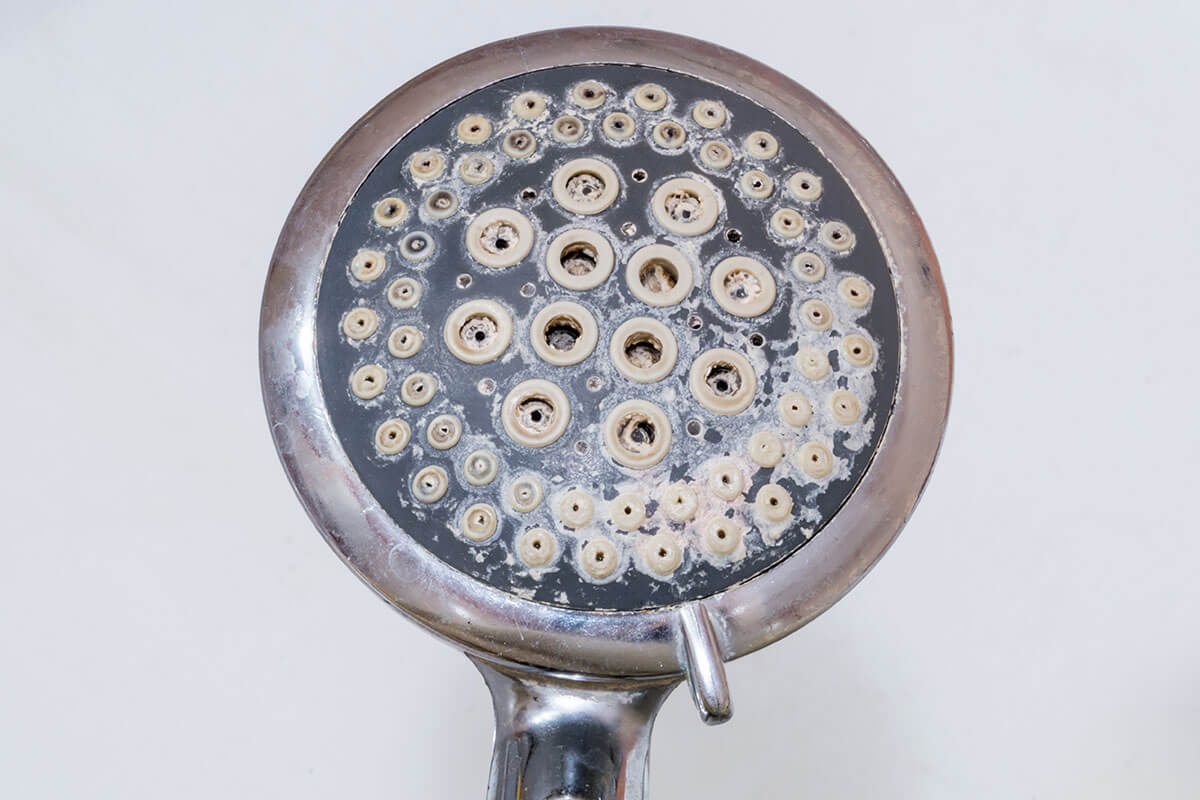
Some models are also equipped with LED lighting. This may sound like a waste of energy, but LED shower heads work in a similar way to dynamo lights for bicycles: the water flowing through them cranks up a mini turbine, which in turn generates the necessary energy. The function therefore requires no electricity. Moreover, the bathroom light no longer has to be switched on for showering.
Price and manufacturer
A shower head usually has a long service life. That is why it is worth investing in a high-quality product. However, this does not mean that all shower heads are expensive. Simple shower handsets are already available for less than $10. Fixed shower heads and especially rain showers, however, are more expensive: sometimes they cost over $100 — plus the costs of installation, unless you do it yourself.
Tips for cleaning and installation
Cleaning the shower heads and fitting them to the hose or holder is rather uncomplicated. You can clean them with simple household products, and do not need any special cleaning agents. Nor should the standardized connector size pose a challenge.
Cleaning
Since limescale deposits reduce the flow rate, shower heads must be cleaned regularly. This keeps the shower hygienic. The process doesn’t take much time: fill a bucket with vinegar or citric acid. You should avoid using harsh chemicals. Disassemble the shower and soak it in the bucket for a few minutes. Use a toothbrush to clean the shower head in the appropriate places. Then, dry it with a cloth and reattach it to the hose or the holder. With fixed shower heads, the process can take a little more time because removing the shower head is more cumbersome than with a handset.
If you have a shower handset, you can also use it to clean the shower specifically where dirt occurs. A pressure jet makes cleaning even easier.
Installation
The connectors of shower heads are standardized. Hoses and shower heads should therefore always be compatible. The diameter of the connector is 0.5 inch. So you don’t have to worry about your new shower head not fitting your hose. Simply turn the shower head clockwise onto the hose. To check for leaks, you can run some water. If the connection proves to be leaking, you should tighten it with a suitable tool if necessary. This only pertains to handsets, as only they are attached to a hose.
The installation of fixed shower head is much more cumbersome. Among other things, you have to drill holes in the wall and measure the distances precisely. It is best to follow the manufacturer’s instructions for use. If you still feel unsure, it is recommended that you hire professionals for the installation.
Image 1: © koldunova / stock.adobe.com | Image 2: © FinalCheck | Image 3: © Robson90 / stock.adobe.com

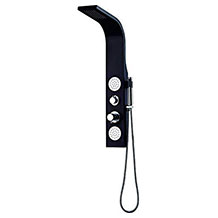
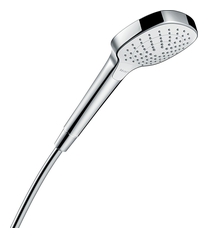











 6,827 reviews
6,827 reviews
